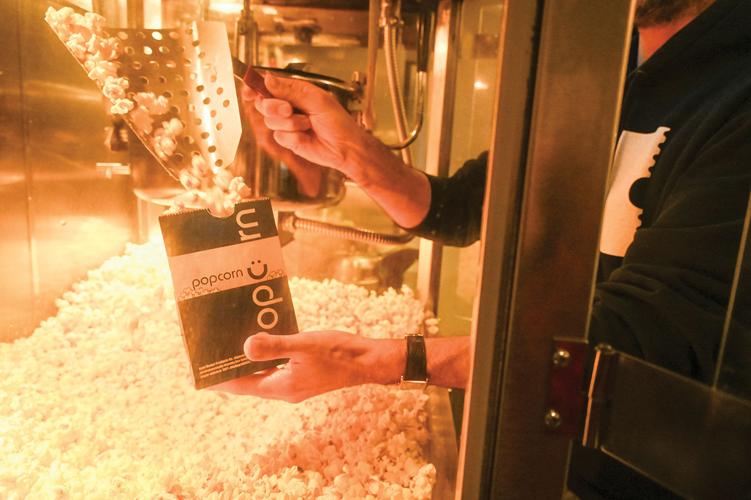In 2020, at the height of the COVID-19 pandemic, movie theaters were about as close to extinction as they have been in more than a century. It’s hard to envision a scenario in which movie houses die off completely. Perhaps a fate similar to that of vinyl records — a medium kept alive by enthusiasts more than casual consumers — is more likely. But after the triple-whammy of COVID, the proliferation of streaming services and the 2023 Hollywood labor disputes, production studios remain skittish about what they green-light, and the way your local theater operates has changed permanently.
But amid the constant chaos of the past half-decade of filmgoing, something else has changed. With a lack of new releases to fill their many screens — and with often homogenous slates on the marquee — megaplexes have begun to host more repertory screenings. A long-held practice for independent theaters, rep screenings have now become major (and relatively cheap) successes for theaters of all kinds. With a post-lockdown desire to get out of the house, and a drive to see classics that can be hard to find on streaming platforms, young film fans are flocking to screenings of old movies.
“There’s no doubt that we’re seeing larger audiences for repertory films on a consistent basis, and younger audiences for repertory films,” says Stephanie Silverman, the Belcourt Theatre’s executive director. “When this kind of kicked off in its current version, I don’t think anyone would have expected that. [In the past] you would have had [late Scene Editor-in-Chief] Jim Ridley and [Belcourt benefactor] Scott Manzler sitting in there by themselves.”
The way forward may very well be independent theaters programming diverse offerings. Earlier this year, The New York Times argued as much, citing the Belcourt as one of the nation’s top examples. Quibbles about labeling Nashville a small town aside, the newspaper of record was right to highlight the local institution.
“I think the Belcourt is special for a lot of reasons, but I think the Belcourt in its current iteration … sort of evolved in Nashville at the same time Nashville was evolving,” says Silverman. “And it was just a perfect meeting of an institution and a programming personality with a city that was growing and finding its own way in the world. … The intersection was, I think, really powerful.”
In New York or Los Angeles, you can find interesting movie theaters in what feels like every neighborhood. But because there are so many of them, their programming is often niche. In smaller towns, what’s popular often has to lead the way. But in Nashville, we have a theater that gives us the best of both worlds. For example, during one week in late April, you could see a brand-new star-laden Steven Soderbergh spy thriller, a 4K re-release of a Pink Floyd concert film, a documentary on 2024’s on-campus Palestinian-solidarity protests, a David Lynch retrospective, the latest from body-horror auteur David Cronenberg and a pair of Charles Burnett restorations. In May, you can see two of the highest-grossing movies of all time (inflation-adjusted) with Jaws and The Sound of Music, and a quasi-documentary about beloved cult musician Swamp Dogg getting his pool painted. It’s a tightrope-traipsing act led by longtime Belcourt programming director Toby Leonard.

“The Belcourt is very much a ‘Coat of Many Colors’ kind of organization,” says Scene senior film critic and longtime Belcourt employee Jason Shawhan. “That’s the thing about the Belcourt that I think, more than anything else, is important. It’s not just the fact that it’s a place to see classic art cinema or to see documentaries that ask difficult questions. It’s the fact that, regardless of your outlook, regardless of what you’re trying to find, the chances are you can go to the Belcourt and have a really good time. … That’s one of the reasons that’s helped it sustain and helped bring in new audiences.”
In addition to the usual new releases and rep screenings, the Belcourt is known for programming can’t-miss series centered on specific directors, years or film movements. There’s also the In Tribute series, which honors film legends who have died in the previous year. These splashy events almost always bring in audience members in droves.
In June of last year, the Belcourt hosted one of its most ambitious series yet: a 25-film, monthlong slate celebrating the movies of 1999 — often lauded as one of cinema’s best, most influential years. The 1999 series was a truly impressive feat of programming that inspired the likes of Mayor Freddie O’Connell to chime in with an in-depth opinion piece on the series for the Scene.
“We knew it was a great year for movies, which of course means lots of movies that people saw and will want to see again,” says Silverman of the 1999 series, which included The Matrix, The Sixth Sense, Eyes Wide Shut and Toy Story 2 among its 25 titles. “We didn’t have any idea that it would be the hit that it was. It rivaled any first-run film that we would have put on screen. It was really a remarkable feat. Some of it is just really smart programming. But also, it’s that we spend money to market movies, and that is not a thing that the movie industry does.”
When asked to single out just one special Belcourt series over the years, both Silverman and Shawhan cite the monumental 2011 Visions of the South series, a 22-film slate focusing on overlooked depictions of the South on screen that featured work by directors from Elia Kazan to David Gordon Green.

“The fact that the Belcourt is still a constant is really amazing,” says Shawhan. “Everything else that I remember from that period of time [when I first began seeing films there] is either moved or gone or not even something that people talk about nostalgically. It’s just forgotten. … Anytime something can hang on, despite the utter insanity of the things that are changing around them, I think that’s a sign that something good is going on there.”
Even so, the Belcourt isn’t afraid to evolve to meet the needs of filmgoers and filmmakers.
“I still want 70 [mm] in here somehow,” says Silverman. “Filmmakers love it and are making the prints now, so we’re going to be here for them.”
The beloved Nashville nonprofit celebrates its 100th birthday this week





